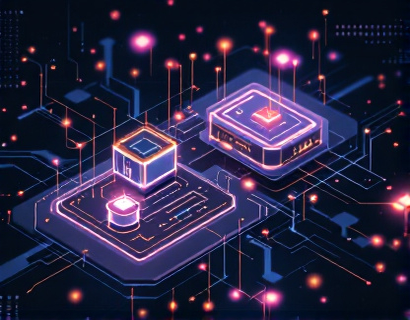Mastering Digital Currency Creation: A Guide to Cutting-Edge Software for Businesses and Blockchain Innovators
In the rapidly evolving landscape of blockchain technology, the ability to create and manage digital currencies has become an essential skill for businesses and innovators. This guide delves into the advanced software tools designed to simplify and enhance the process of digital currency creation, focusing on customization, security, and scalability. By leveraging these cutting-edge solutions, both novices and experts can confidently navigate the complex world of blockchain development.
Understanding Digital Currency Creation
Digital currencies, also known as cryptocurrencies, operate on blockchain technology, a decentralized ledger that records transactions across multiple computers. Creating a digital currency involves several steps, including designing the currency's specifications, developing the blockchain, and implementing security measures. The process can be daunting, but with the right software, it becomes more manageable and accessible.
Key Features of Advanced Digital Currency Software
Modern software for digital currency creation offers a suite of features that cater to the diverse needs of users. These features include:
- Customization options for currency design
- Robust security protocols
- Scalability to handle increasing transaction volumes
- User-friendly interfaces for ease of use
- Comprehensive documentation and support
Customization is a critical aspect, allowing creators to define the unique properties of their digital currency, such as the total supply, block time, and reward mechanisms. Security features ensure that transactions are tamper-proof and that the currency is resistant to attacks. Scalability ensures that the currency can grow without performance issues, making it suitable for widespread adoption.
Customization Options
One of the most powerful aspects of advanced digital currency software is its customization capabilities. Creators can tailor various parameters to fit their specific use cases. For instance, the total supply of a digital currency can be set to mimic traditional currencies or designed to have deflationary or inflationary properties. The block time, which determines how often new blocks are added to the blockchain, can be adjusted to balance security and transaction speed.
Additionally, creators can define unique features such as smart contract support, which allows for more complex and automated transactions. Custom symbols and branding elements can also be integrated to give the currency a distinct identity. This level of control ensures that the digital currency aligns with the vision and goals of the creator.
Robust Security Measures
Security is paramount in the world of digital currencies. Advanced software implements multiple layers of security to protect the currency and its transactions. These measures include:
- Cryptographic algorithms for secure transaction validation
- Multi-signature wallets for enhanced security
- Regular security audits and updates
- Protection against common attacks such as 51% attacks and double-spending
Cryptographic algorithms ensure that transactions are secure and verifiable, while multi-signature wallets add an extra layer of protection by requiring multiple approvals for significant transactions. Regular security audits help identify and mitigate vulnerabilities, and protection against common attacks ensures the currency remains resilient in the face of threats.
Scalability Solutions
As digital currencies gain popularity, the ability to scale is crucial. Advanced software addresses this by incorporating scalable solutions that can handle increasing transaction volumes without compromising performance. Some key scalability features include:
- Sharding, which divides the blockchain into smaller, manageable parts
- Layer 2 solutions for off-chain transactions
- Dynamic block size adjustments
- Efficient consensus mechanisms
Sharding enhances performance by distributing the blockchain's data across multiple nodes, reducing the load on each individual node. Layer 2 solutions, such as state channels and sidechains, allow for faster and cheaper transactions off the main blockchain. Dynamic block size adjustments ensure that the blockchain can accommodate more transactions during peak times, while efficient consensus mechanisms like Proof of Stake (PoS) reduce the computational power required for validation.
User-Friendly Interfaces
For both beginners and experienced developers, a user-friendly interface is essential. Advanced digital currency software provides intuitive dashboards and step-by-step guides to simplify the creation process. These interfaces often include visual tools for designing block structures, setting parameters, and monitoring transaction activity. By reducing the learning curve, these tools make blockchain development accessible to a broader audience.
Documentation and support are also critical components. Comprehensive guides, tutorials, and community forums provide valuable resources for users to troubleshoot issues and optimize their currencies. This support system ensures that creators can overcome challenges and fully leverage the software's capabilities.
Case Studies and Success Stories
Several projects have successfully utilized advanced digital currency software to create robust and innovative currencies. For example, a fintech company used the software to launch a stablecoin with smart contract integration, enabling automated interest calculations and dividend distributions. Another project created a utility token for a decentralized gaming platform, leveraging the software's customization options to design a token that rewards players for engagement and contributions.
These success stories demonstrate the versatility and effectiveness of advanced digital currency software. By providing the tools and support needed to create secure, customizable, and scalable currencies, these solutions empower businesses and innovators to achieve their goals in the blockchain space.
Future Trends in Digital Currency Creation
The landscape of digital currency creation is continually evolving, with new trends and technologies emerging. Some key trends to watch include:
- Integration with Internet of Things (IoT) devices
- Enhanced interoperability between different blockchains
- Increased adoption of decentralized finance (DeFi) protocols
- Regulatory frameworks supporting digital asset innovation
Integration with IoT devices can enable new use cases, such as tokenized assets for smart homes or supply chain management. Enhanced interoperability allows for seamless interactions between different blockchains, fostering a more connected ecosystem. The rise of DeFi protocols offers new financial opportunities, and supportive regulatory frameworks can accelerate innovation and adoption.
As these trends develop, advanced digital currency software will continue to adapt, offering new features and tools to meet the changing needs of creators. Staying informed about these developments is crucial for staying ahead in the blockchain space.
Conclusion
Mastering digital currency creation is no longer the domain of tech experts alone. With advanced software designed to provide customization, robust security, and scalability, businesses and blockchain innovators can confidently enter and thrive in the digital currency market. By leveraging these tools, creators can design currencies that meet their specific needs and contribute to the growth and innovation of the blockchain ecosystem.
Whether you are a business looking to launch a new currency or an enthusiast eager to explore the possibilities of blockchain, the right software can make all the difference. Embrace the tools at your disposal and join the forefront of this exciting and transformative technology.










































